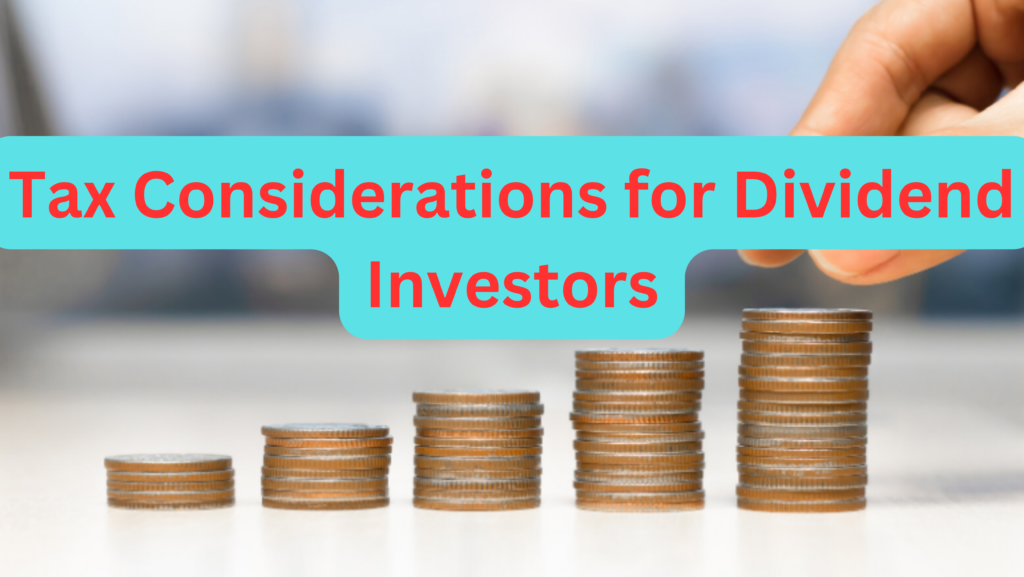Are you making money from dividend stocks? That’s great! But do you know how those dividends are taxed? Many investors focus on growing their portfolios but overlook the tax impact. If you’re not careful, taxes can take a big bite out of your profits.
In this post, you’ll learn everything you need to know about Tax Considerations for Dividend Investors. We’ll break down tax rates, strategies to minimize your tax burden, and how different account types can impact your earnings. By the end, you’ll have a clear strategy to keep more of your hard-earned dividends.
Understanding Dividend Taxes
Before you start optimizing your taxes, you need to understand how dividends are taxed. Not all dividends are treated the same, and knowing the difference is crucial.
1. Qualified vs. Non-Qualified Dividends
The IRS classifies dividends into two main types: qualified and non-qualified.
- Qualified Dividends – These are taxed at lower capital gains rates (0%, 15%, or 20%) instead of ordinary income rates. To qualify, you must hold the stock for a certain period, and the company must be a U.S. or eligible foreign corporation.
- Non-Qualified Dividends – These are taxed as ordinary income, meaning they can be taxed at a rate as high as 37%, depending on your tax bracket.
Why does this matter? Because the difference between a 15% tax rate and a 37% tax rate can significantly impact your profits.
2. Dividend Tax Rates Based on Your Income
Your tax rate depends on your total taxable income. Here’s how qualified dividends are taxed:
- 0% Tax Rate: If your taxable income is below $44,625 (single) or $89,250 (married filing jointly), you pay no tax on qualified dividends.
- 15% Tax Rate: If your income falls between $44,625 and $492,300 (single) or $89,250 and $553,850 (married filing jointly), you pay 15% on qualified dividends.
- 20% Tax Rate: If your income exceeds those thresholds, you pay 20% on qualified dividends.
Non-qualified dividends, however, are taxed as ordinary income, meaning they could be taxed at rates from 10% to 37%, depending on your total earnings.

Strategies to Minimize Taxes on Dividends
Now that you understand dividend taxation, let’s look at ways to reduce your tax bill and keep more of your investment returns.
3. Use Tax-Advantaged Accounts
One of the best ways to avoid taxes on dividends is to hold dividend-paying stocks in tax-advantaged accounts like:
- Roth IRA – Since contributions are made with after-tax dollars, qualified withdrawals (including dividends) are tax-free.
- Traditional IRA & 401(k) – These accounts allow your investments to grow tax-deferred until withdrawal. However, when you withdraw, you’ll pay taxes on the total amount at your ordinary income tax rate.
If you plan to hold dividend stocks for the long term, a Roth IRA can be a powerful tool to shield your earnings from taxes.
4. Optimize Your Portfolio for Tax Efficiency
Not all stocks should be held in the same type of account. Here’s a smart tax strategy:
- Hold high-dividend stocks in tax-advantaged accounts (Roth IRA, Traditional IRA). This prevents high dividend payouts from increasing your taxable income.
- Hold growth stocks in taxable accounts (regular brokerage accounts). Growth stocks generate capital gains, which are taxed at lower rates than non-qualified dividends.
This strategy ensures you’re paying as little tax as possible while maximizing your investment returns.
5. Take Advantage of Tax-Loss Harvesting
Tax-loss harvesting allows you to offset dividend taxes by selling losing investments. Here’s how it works:
- If you have a stock that has lost value, you can sell it to realize a capital loss.
- You can then use that loss to offset gains from other investments, including taxable dividend income.
- You can deduct up to $3,000 per year in capital losses against ordinary income.
By strategically selling underperforming stocks, you can reduce your taxable income and minimize taxes on dividends.
6. Be Mindful of the Net Investment Income Tax (NIIT)
High earners face an additional 3.8% Net Investment Income Tax (NIIT) on dividends and other investment income. You’ll owe this tax if your modified adjusted gross income (MAGI) exceeds:
- $200,000 for single filers
- $250,000 for married couples filing jointly
If you fall into this category, you may want to use tax-efficient funds or accounts to reduce exposure to the NIIT.
Tax Implications of Foreign Dividends
Investing in international stocks can diversify your portfolio, but it also comes with additional tax considerations.
7. Foreign Dividend Withholding Taxes
Many countries withhold taxes on dividends before they reach your account. These taxes can be as high as 30%, depending on the country.
However, the Foreign Tax Credit allows you to claim a credit for these taxes, reducing your U.S. tax bill. To take advantage of this, you must file Form 1116 with your tax return.
8. Tax Treaties Can Reduce Your Burden
Some countries have tax treaties with the U.S. that lower the withholding rate on dividends. For example:
- Canada – 15% withholding tax if held in a taxable account, 0% if held in an IRA.
- United Kingdom – No withholding tax on dividends paid to U.S. investors.
- Switzerland – 35% withholding tax, but you can reclaim a portion with proper paperwork.
If you invest in international dividend stocks, check tax treaty agreements to minimize foreign tax withholding.
Conclusion
Understanding Tax Considerations for Dividend Investors is crucial to maximizing your returns. By choosing tax-efficient accounts, taking advantage of credits and deductions, and planning your portfolio wisely, you can significantly reduce your tax bill and keep more of your dividend income.
Are you currently using tax strategies to manage your dividend income? Leave a comment below and share your experience!



